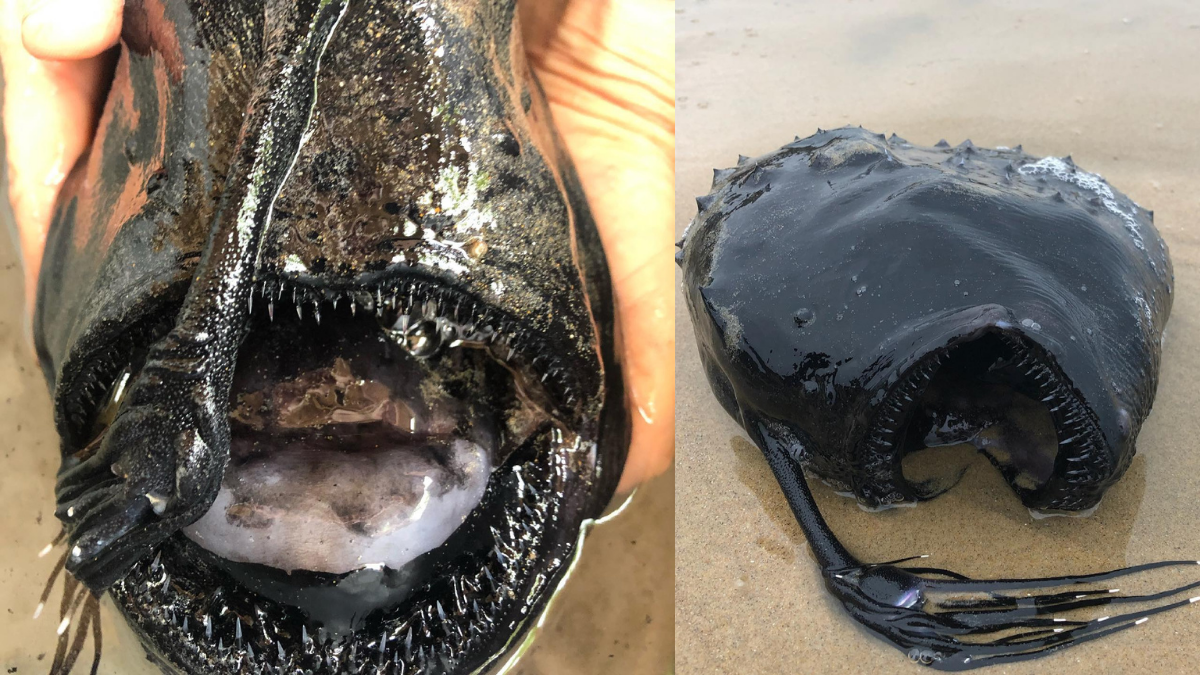In early May 2021, photos of an “amazingly rare” anglerfish known as a Pacific footballfish went viral after it was reported that the animal had washed ashore in southern California.
Davey’s Locker Sportfishing and Whale Watching, a recreational guide company based in southern California, posted the photos on May 8 and as of this writing, they had been shared more than 125,000 times.
“State park rangers and lifeguards with Crystal Cove State Park were alerted to a weird looking fish that washed ashore Friday morning from beach visitor Ben Estes who happened to notice it on the sand,” wrote the company, adding that the fish was reportedly found on May 7 at Crystal Cove State Park in Newport Beach, California. The park subsequently shared photos of the fish to Facebook on May 10.
The 18-inch fish was identified as a Pacific footballfish, a species of anglerfish that are normally found between 2,000 and 3,300 feet below the ocean surface. And though it's rare to have a fish of this species in a museum collection, California Academy of Science Curator of Ichthyology Dave Catania said that doesn't necessarily mean they are rare in the wild.
"The deep oceans are poorly sampled, so it's possible they are common at depth, we just don't know," Catania said in an email to Snopes.
Anglerfish are identified by their illicium, a long fleshy dorsal fin that extends past the front of the mouth and has a phosphorescent bulb (or esca) on the end to emit light and lure “unsuspecting prey.”
Scientifically known as Himantolophus sagamius, the California Academy of Sciences described the Pacific football fish as having “prickly skin, needle-sharp teeth, minuscule eyes, and a strange stalk on its head.”
Sunlight doesn’t penetrate the depths at which the Pacific footballfish live; and because food is scarce in the deep, their esca is a special evolutionary advantage that helps them to entice whatever fits in their mouth, from other fish to squid and crustaceans. The glow of the esca comes from photobacteria that emit light, flowing into the point through small pores — when inside, they survive on the nutrition provided by the host.
“Using its esca as a lure, an anglerfish remains motionless until prey comes within striking distance. In a lightning-fast motion, it sucks the prey into its mouth, where its teeth — which point inward — ensure that what goes in doesn’t come out,” wrote the academy.
It is not yet known whether the California footballfish is male or female, but the two genders are known to differ dramatically in size — some females can measure up to ten times larger than their male counterparts.
“The males of some anglerfish species, including the football fish, have evolved into ‘sexual parasites.’ Using well-developed olfactory organs, they find and fuse themselves to females, eventually losing their eyes, internal organs, and everything else but the testes,” noted the academy. “The male becomes a permanent appendage that draws nutrition from its female host and serves as an easily accessible source of sperm.”
Catania noted that the current specimen appeared to be in "excellent condition," suggesting it was likely not killed as a result of predation.
"A necropsy might shed light on the cause of death," he said. "As far as reaching the surface, disease might have rendered her incapable of maintaining depth. Ocean currents could have played a part."
There are more than 300 living species of anglerfish, scientific order Lophiiformes, found around the world, all of which are considered bony fish. California Department of Fish and Wildlife (CDFW) told Snopes that they were made aware of the anglerfish by the Orange Coast District of California Department of Parks and Recreation and as of this writing, the fish is frozen at Crystal Cove State Parks. CDFW added that they put the park service in contact with the Natural History Museum of Los Angeles to arrange for a transfer.

